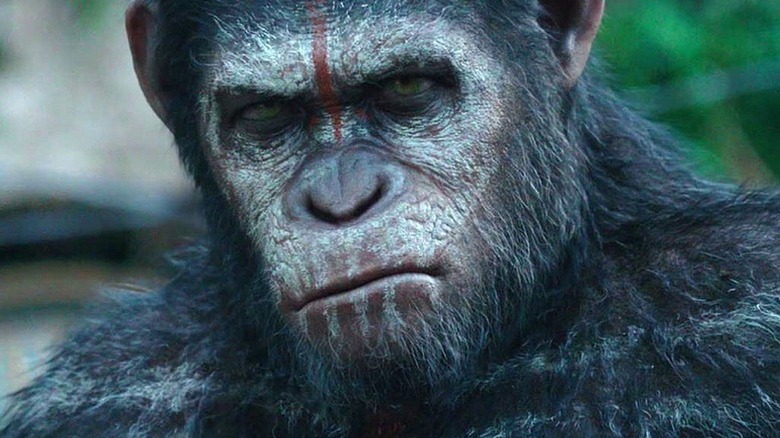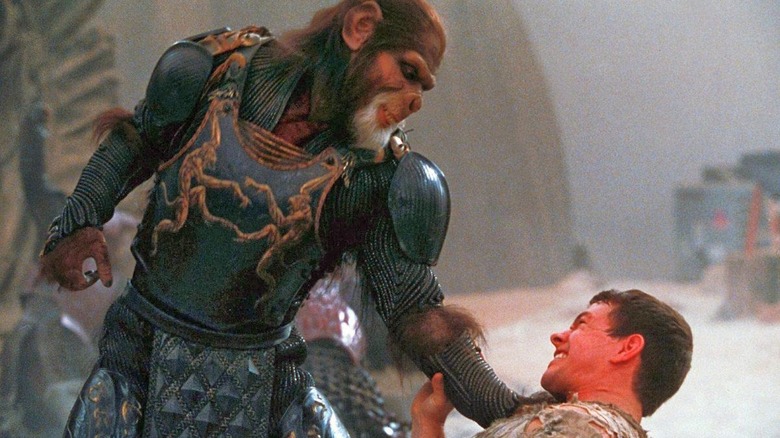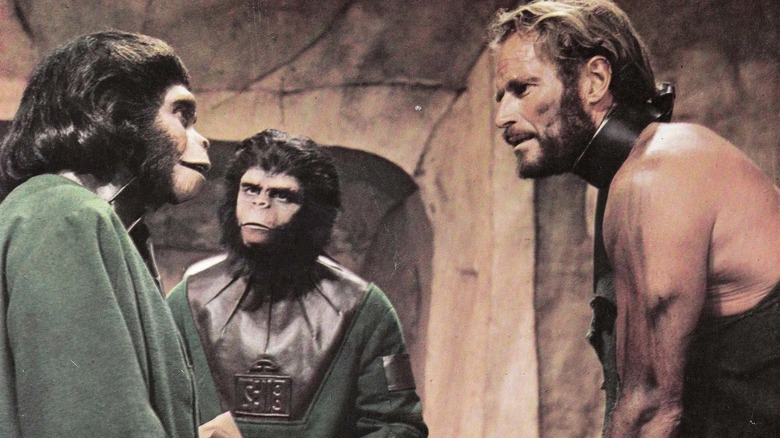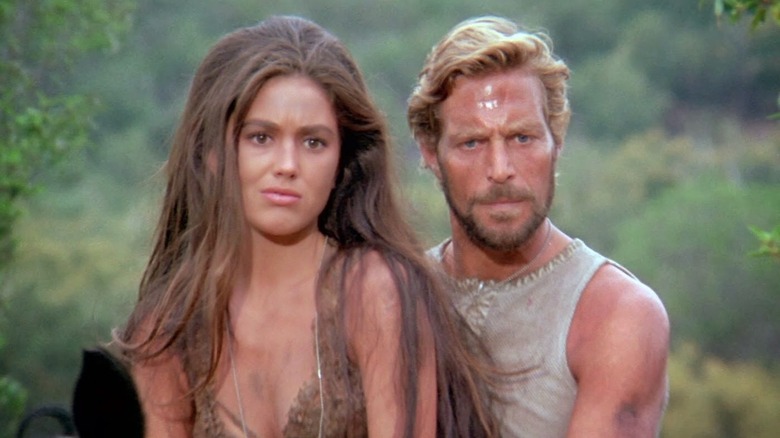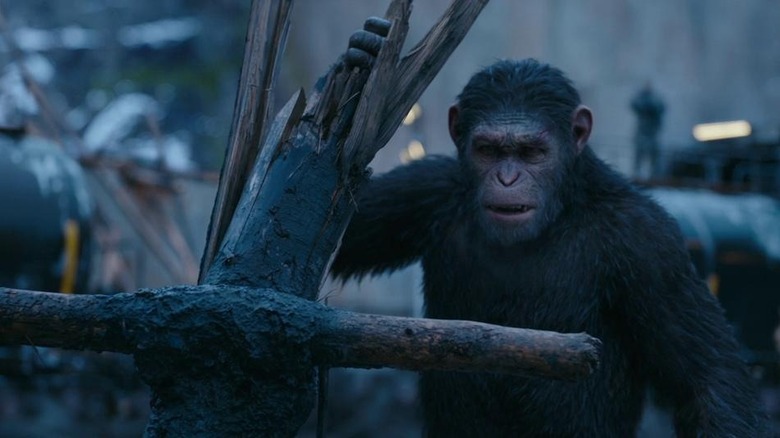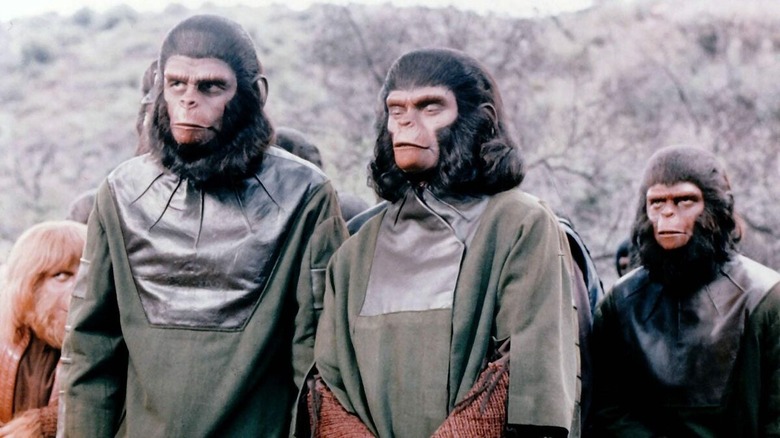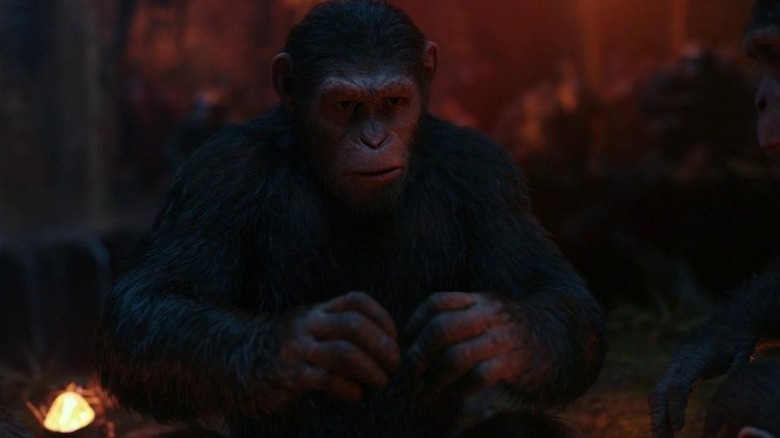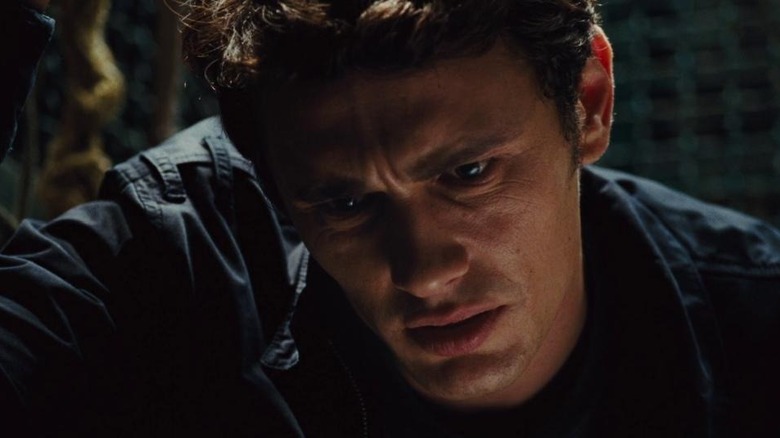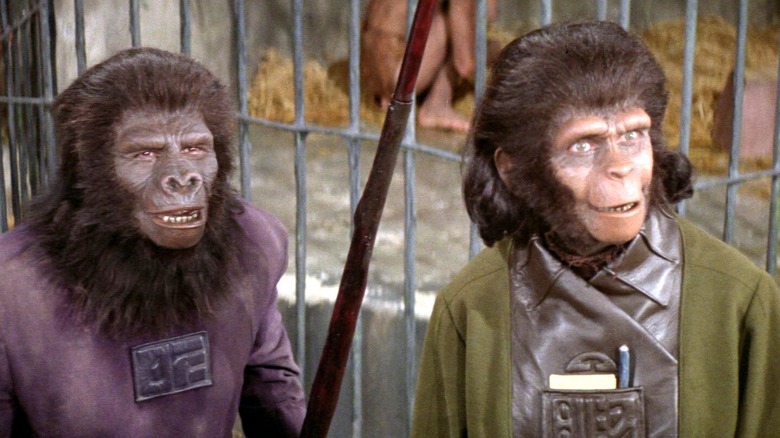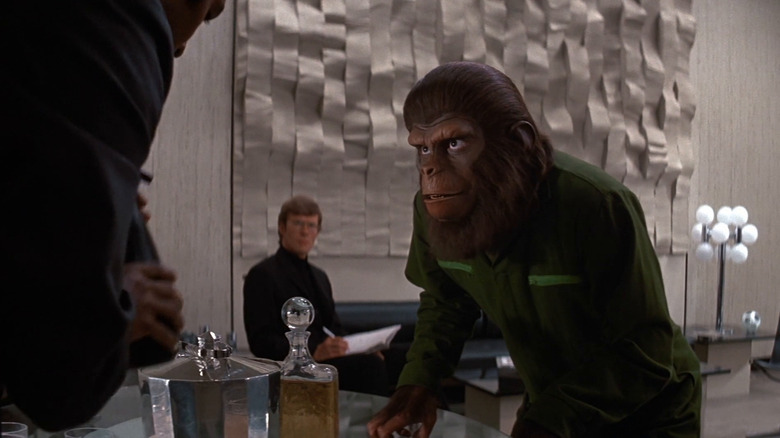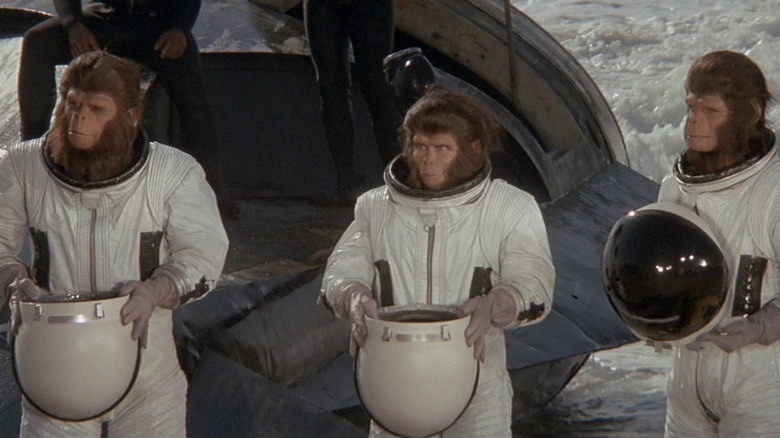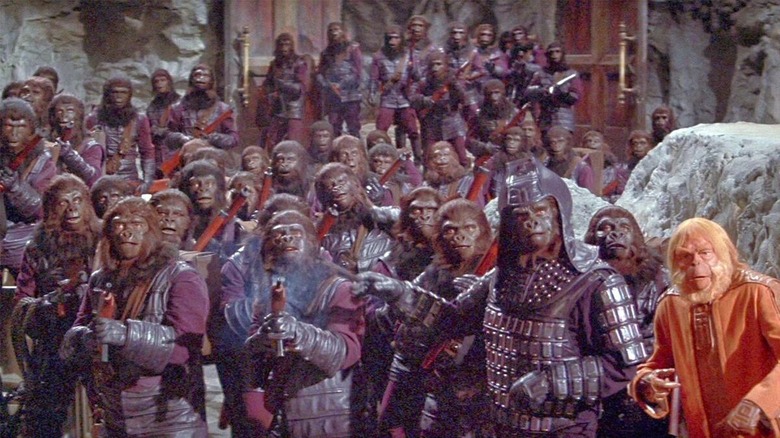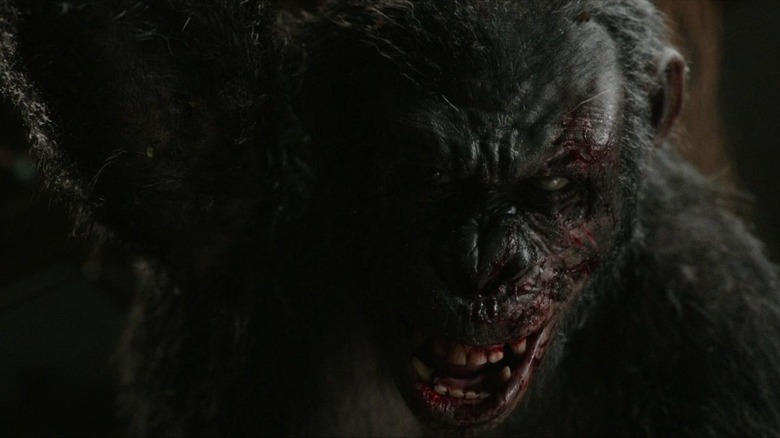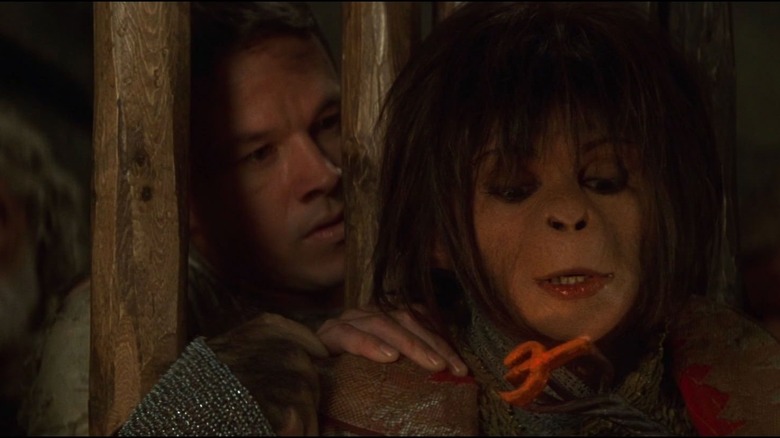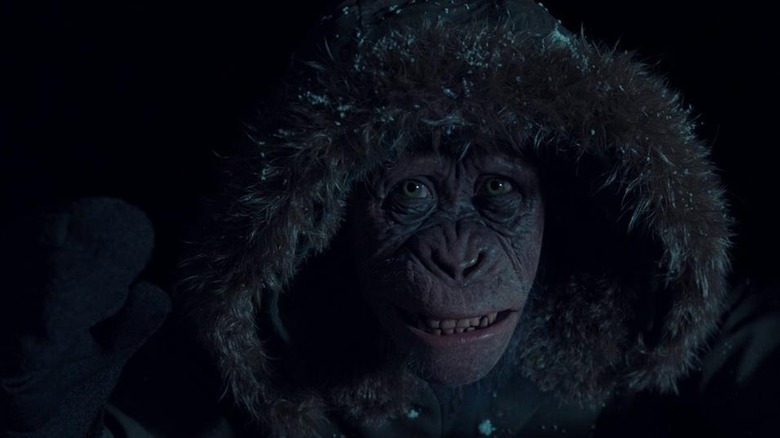Planet Of The Apes: The 7 Best And 7 Worst Things From The Franchise
While the term "monkeying around" is often used in a negative sense, the "Planet of the Apes" movies have constantly shown that it can yield some incredibly entertaining filmmaking. Starting with the 1968 feature "Planet of the Apes," this franchise has proceeded to deliver not just exciting stories, but a dense lore that has captivated the minds of moviegoers for generations. These may be preposterous yarns about talking apes who ride horses and dominate human beings, but they're often told with real thoughtfulness and tangible pathos, not to mention incisive social commentary that's eternally relevant. More often than not, the "Planet of the Ape" adventures go above and beyond what you'd expect from the basic concept of this whole saga.
Of course, the "Planet of the Apes" series has been around for nearly 60 years and spawned nine different movies (with a 10th on the way), so not everything within this franchise is going to be golden. But the low points of this saga are often still interesting in terms of unpacking why they're so miscalculated, and often make you appreciate the virtues of the series even more. Examining the best and worst things in the "Planet of the Apes" franchise is an utterly fascinating exercise that, above all else, allows one to be conscious of how much artistic ambition has permeated a bunch of movies about "monkeying around."
Worst: The grimness of 2001's Planet of the Apes remake
If there's a nadir to be found in the "Planet of the Apes" franchise, it has to be the 2001 remake helmed by Tim Burton and simply titled "Planet of the Apes." Despite some excellent makeup work to realize the ape characters and a handful of memorable performances from actors like Paul Giamatti, the whole film is a tired snooze. The key reasons for this "Planet of the Apes" not working are numerous, but one chief problem is how oppressively grim and serious this whole project is.
The "Planet of the Apes" movies have never been comedies, but they've often had a light touch or at least some entertainment to offer in between dramatic plot turns or weighty pieces of social commentary. Burton's "Planet of the Apes," meanwhile, is just all frowns all the time, with minimal attempts at any kind of excitement or fun. Worse, it's a project that never figures out why it should be so gloomy. "War for the Planet of the Apes," for instance, delivered character motivations and plot developments that warrant a bleaker tone. "Planet of the Apes," meanwhile, can never figure out why a movie where Mark Wahlberg talks to humanoid apes is such a slog. Any of the whimsy or eccentric imagination that defined Burton's greatest films is totally absent in the suffocatingly straight-faced "Planet of the Apes."
Best: The original Planet of the Apes
Certain lines and scenes from the original 1968 "Planet of the Apes" have become so iconic that newer generations may not even realize where they originated from. Charlton Heston shouting "Get your hands off me, you damn dirty ape!" or the shot of a crumbling Statue of Liberty are just two examples of "Planet of the Apes" moments that are still leaving a ripple effect on pop culture. The ubiquity of this film and just how familiar it feels to people now may run the risk of making "Planet of the Apes" feel stale rather than revolutionary. However, no amount of rehashing of its most famous lines can dilute the fact that "Planet of the Apes" still holds up as a classic.
Countless aspects of this movie still register as timelessly incredible, such as the make-up effects for the apes or Charlton Heston's fully committed performance as a man coming to terms with an ape-dominated society. It's also delightful how the film doesn't sacrifice instances of enjoyably goofy humor (such as a trio of apes mimicking the "see no evil, hear no evil, speak no evil" chimps), even as its narrative tackles weighty ideas. You get so much bang for your buck when watching "Planet of the Apes" and no amount of pop culture ubiquity can take away from its deluge of charms.
Worst: Charlton Heston's awkward removal from Beneath the Planet of the Apes
At the start of 1970's "Beneath the Planet of the Apes," the first sequel to "Planet of the Apes," we follow the previous film's protagonist, Taylor (Charlton Heston), as he makes his way through the Forbidden Zone with Nova (Linda Harrison). This is just where the characters were at the end of "Planet of the Apes," but a huge shift in the status quo is about to emerge. A pillar of fire, a chasm in the ground, and finally a wall of stone appear out of nowhere to block their path. Taylor goes to inspect the latter and promptly vanishes until the very end of the movie, which culminates in both his death and the destruction of the entire planet.
It's utterly peculiar to have the protagonist of "Planet of the Apes" suddenly vanish right at the start of "Beneath the Planet of the Apes," an awkward storytelling turn that the movie can never make organic. The reason for this strange twist is because of Heston's refusal (via Den of Geek) to come back for a sequel, with the actor eventually returning only under the condition that his screentime be minimal. Heston was pleased with this arrangement, but his benefit was to the detriment of "Beneath the Planet of the Apes," which started on the weird note of ditching a character that audiences had just spent an entire movie getting invested in.
Best: Attempts at social commentary
The original "Planet of the Apes" came out in 1968, at the tail end of a decade that had put civil rights and inequality at the forefront of the minds of Americans. Whether it was the various crusades for rights for Black citizens or events like the Stonewall riots, the injustices foisted upon marginalized groups were more apparent than ever. The "Planet of the Apes" films weren't afraid to nod in the direction of hot-button issues that are still tragically relevant decades later.
"Escape from the Planet of the Apes," for instance, uses time travel to have apes Cornelius and Zira wind up in the past. Their ensuing exploits and the hostile way they're treated by Americans serve as an exploration of how American society demonizes those it deems "the other." Intolerance against marginalized people continues to be a prominent theme in the next movie, "Conquest of the Planet of the Apes." Even the more recent "Apes" installments aren't afraid to probe enduring problems in human society. "War for the Planet of the Apes" defines its human villains as adversaries by the way they cling to American jingoism and prejudice. In this post-apocalyptic landscape, these toxic qualities are all people cling to as vestiges of "humanity."
With these and other confrontations of societal woes scattered throughout the franchise, it's clear that audiences come to "Planet of the Apes" movies for entertaining monkey adventures but stay for thoughtful social commentary.
Worst: The disappointment of Battle for the Planet of the Apes
The original "Planet of the Apes" movies ground to a halt with 1973's "Battle for the Planet of the Apes." Given how frequently installments in this franchise had been produced up to this point, it's shocking to consider that the series would suddenly just stop. Then again, a movie as critically reviled as "Battle for the Planet of the Apes" was bound to make everyone feel like there was nowhere for this saga to go. All the promise of the "Planet of the Apes" universe had seemed to be tapped out with this largely detested installment.
The biggest complaint about "Battle for the Planet of the Apes" across the board was its budgetary restrictions. Previous "Planet of the Apes" movies had dazzled with their lavish makeup effects and production design. "Battle," by contrast, brought cut-rate spectacle that was thoroughly underwhelming. There were also repeated criticisms over how wooden the performances were, while the lack of fresh new narrative twists compared to its predecessors was also lambasted. Everything about "Battle for the Planet of the Apes" was a crushing disappointment, but thankfully the franchise wouldn't stay in hibernation forever after its release. "Planet of the Apes" would return in 2001 for a remake before getting revived for good in 2011 with "Rise of the Planet of the Apes," a film that finally washed the bad taste of "Battle for the Planet of the Apes" out of everyone's mouth.
Best: The most recent trilogy's tone
The trio of "Planet of the Apes" films that began with "Rise of the Planet of the Apes" brought a welcome new tone to the franchise. These features were unafraid to go dark and treat their characters with gravity. "Rise" depicts a man struggling with Alzheimer's with real weight, same with the struggles of Caesar (Andy Serkis) as he adjusts to life alone in captivity. "War for the Planet of the Apes" takes this darkness to its extreme by featuring apes getting carted away to what amounts to concentration camps. These movies were willing to take the "Planet of the Apes" universe to serious places, but the beautiful thing about them was that they weren't all gloominess all the time.
The 21st century "Apes" films were always conscious that these were movies about hyper-intelligent monkeys doing preposterous things and weren't afraid to lean into that. "Dawn of the Planet of the Apes" still proudly features simians on horseback firing off guns, while "War for the Planet of the Apes" makes time for apes to throw feces at humans. Even better, these films don't use their serious nature as an excuse to coat every frame in miserable gray hues. The finale of "Rise of the Planet of the Apes" takes place in vivid sunlight, while "War for the Planet of the Apes" departs from its snowy backdrops for a digression set on a brightly lit beach. These "Apes" movies had appropriate and wonderfully layered tones for such thematically complex features.
Worst: James Franco's forgettable performance
So much of "Rise of the Planet of the Apes" is way better than it has any right to be. The thought of a "Planet of the Apes" prequel sounded dreadful, but in execution, the project showed smarts through a willingness to take its plot slow and keep it intimate. In its narrative and visual effects, "Rise of the Planet of the Apes" soared above expectations. Unfortunately, the one unavoidably disappointing aspect of the feature is the performance delivered by James Franco as the film's most prominent human being, Dr. Will Rodman.
A scientist working overtime to find a cure for Alzheimer's, which plagues his father Charles (John Lithgow), Rodman ends up growing attached to Caesar, the offspring of one of his test monkeys. Franco doesn't have a ton to work with in terms of depth, admittedly, but his performance is still flat, and lacks a discernible personality. It's especially strange since it's not like all the other humans in "Rise of the Planet of the Apes" are disposable and tedious so that the CG apes can shine. The likes of Lithgow, David Oyelowo, and Brian Cox all portray notable humans and each deliver solid supporting performances, with Lithgow especially excelling by bringing gravity and nuance to his tormented character. Unfortunately, this just underscores how much Franco is phoning it in, in a movie that otherwise surpasses expectations in so many ways.
Best: Makeup work on the apes
It's impossible to overstate how important John Chambers was in the world of makeup effects and design. His extensive legacy as an artist includes being responsible for the ape makeup effects in "Planet of the Apes." With his work, these creatures straddled an important line between looking convincingly like primates and letting the features of their human performers come out. It's an impressive accomplishment that was achieved without evoking the uncanny valley. Even better, it set a precedent for the "Planet of the Apes" movies to feature makeup effects for the ape characters that were constantly dazzling audiences.
Even in a film with only a handful of ape characters like "Escape from the Planet of the Apes," the makeup effects in these movies is still impressive. The legacy of this franchise's makeup wizardry even extends to one of its worst installments: The 2001 "Planet of the Apes" featured a makeup team headed by Rick Baker who were tasked with coming up with effects for a wide range of primates. Their results were incredibly detailed, lifelike, and varied. Even if an "Apes" movie is forgettable, it's bound to feature makeup effects that are as astonishing as ever.
Worst: The reshot ending of Conquest of the Planet of the Apes
The ending of "Conquest of the Planet of the Apes" was originally supposed to be an incredibly bleak conclusion that would have sealed the idea that the apes were taking over as the dominant force on Earth. Caesar (Roddy McDowall), with the movie's unnamed human city in flames behind him, delivers a stirring speech in which he talks about once bustling human cities being desolate and man's weapons inevitably destroying mankind itself. Caesar concludes his speech by proclaiming to the captured humans that the day of apes taking over "is upon you ... now!" He then watches impassively as a band of gorillas beats the sadistic Governor Breck (Don Murray) to death.
The speech made the final cut of "Conquest of the Planet of the Apes," but test screening audiences found that it and Breck's brutal demise were too dark. Worried about alienating rather than entertaining prospective moviegoers, 20th Century Fox ordered that the ending be overhauled. While the original speech was retained, McDowall recorded a new follow-up monologue in which he also preaches compassion for humanity, while hastily-edited footage removes Breck's death and makes it seem like some peace has been found between the two species. It's impressive that a new ending was able to be crafted out of new narration and some editing trickery, but it's still an abrupt tonal shift that doesn't fit the preceding movie.
Best: A commitment to standalone sequels
The fun part about the original "Planet of the Apes" saga is how it does form one long narrative. Even though it spans vastly different centuries, these films eventually do weave a storytelling tapestry depicting how Earth went from being dominated by human beings to one controlled by apes. However, in following up the original "Planet of the Apes," the creative voices behind subsequent installments in the franchise wisely opted to make sure the movies could stand on their own. While knowing other "Planet of the Apes" movies is helpful to understand some aspects of the saga, they're not essential to enjoying features like "Conquest of the Planet of the Apes."
Constantly shifting around the protagonists and tones of individual titles helped the various "Planet of the Apes" sequels function as enjoyable standalone productions rather than just prolonged and repetitive mush dragged out over countless movies. Happily, this trend even continued with the "Apes" movies made after the 2001 "Planet of the Apes" remake. "Rise of the Planet of the Apes" has a handful of Easter eggs referencing earlier "Apes" films, but it largely functions as a standalone work. Its sequels would build off everything "Rise" developed, but they too have a concrete beginning, middle, and end. The lore of the "Planet of the Apes" movies is expansive, but general audiences love this world so much because the individual installments work so well as complete stories.
Worst: The ape masks in Beneath the Planet of the Apes
If there's an issue with the incredible legacy of the makeup work in the "Planet of the Apes" movies, it's that any sudden downward shift in quality is going to be glaringly apparent. You can't just throw out a C-level effort in a franchise famous for delivering A-grade ape makeup work. This was a problem that became apparent during certain spots in the first "Planet of the Apes" sequel, "Beneath the Planet of the Apes." The movie was infamous for being plagued with budgetary issues as 20th Century Fox kept slashing how much money the follow-up would receive.
As a result, the ape makeup in this film was a considerable step down from the original movie. Almost all ape extras in the film wore much more simplified pullover masks rather than elaborate ape makeup. What helped the bottom line of 20th Century Fox was a significant drawback to "Beneath the Planet of the Apes," which featured some distractingly cheap means of realizing apes that clashed with the traditional and intricate makeup effects of the film's primary ape characters. Such a shortcoming is impossible to miss, given the makeup wizardry of the best "Apes" installments.
Best: Everything about Koba
First introduced as a test subject for human experimentation in "Rise of the Planet of the Apes," the primate Koba (Toby Kebbell) transforms in "Dawn of the Planet of the Apes" into an incredibly tragic villain. Make no mistake, Koba is a wicked individual, with his unabashedly evil tactics being a key reason why he's such a compelling villain. He's willing to kill Caesar or any other apes who question him in his pursuit of revenge against all human beings. Koba is a terrifying creature, particularly in the scene where he puts on an act of being a simple chimp in front of gullible humans so that he can get closer to their weapons.
However, Koba is given extra layers of depth by all the tragedy that's formed his bleak outlook on humanity. This monkey doesn't just wake up one day and randomly hate humans: he experiences years and years of physical torture at their hands. Physically and emotionally scarred by his past, Koba's rage is chilling, but also one the audience can understand psychologically. He's an incredibly complex individual, with his nuances made more impressive by how they are organically built upon by his fleeting appearances in "Rise of the Planet of the Apes." He isn't given much personality or screen time in that movie, but there are still vibrant hints of Koba's animosity towards humans. Who knew when watching that movie that an all-time great blockbuster movie baddie was being molded?
Worst: The 2001 remake's terrible twist ending
If you're going to do any kind of remake of "Planet of the Apes," then you're going to have to contend with the original's iconic twist ending. That unforgettable conclusion totally altered how viewers saw the preceding film, when it was revealed, through the sight of a crumbling Statue of Liberty, that the story took place on a future version of Earth taken over by apes. It was an outstanding capper to the film, but you couldn't just replicate it for the remake. After all, a twist ending needs to surprise people and audiences would be expecting a "Planet of the Apes" remake to feature a buried Statue of Liberty. Something new would need to be done, but what this remake came up with was an incoherent mess.
Much like in the original, the 2001 "Planet of the Apes" involves the film's human protagonist stumbling onto a classic American landmark only to realize it's hauntingly different from what he remembered. In this case, Mark Wahlberg's "Apes" character, astronaut Leo Davidson, is sent back to his time on Earth, only to make the shocking discovery that the Lincoln Memorial now has the face of the evil ape General Thade (Tim Roth). From there, a barrage of ape cops pull up, draw out weapons, tell our hero to freeze ... and the movie ends. It's a bizarre cliffhanger that would register as a disaster even if it wasn't going to get inevitably compared to one of the greatest twist endings of all time.
Best: Use of motion capture characters for intimate drama
"Rise of the Planet of the Apes" and its follow-ups make plenty of room for big action set pieces, but what's remarkable about these features, especially "Dawn of the Planet of the Apes" and "War for the Planet of the Apes," is how often they use their motion-capture apes for very quiet and tender sequences. In American cinema, motion capture animated characters are often exclusively used for elaborate action scenes. This revolutionary technology is frequently employed to ensure that fight choreography or characters engaging with big spectacle looks as realistic as possible.
But in these "Apes" films, new possibilities for motion capture characters and animation are explored. Hyper-intelligent apes that could never exist in the real world have a tangibility to their weight as they talk back and forth about the future of their society or quietly try to coax a child out of hiding. Incredibly subtle details emerge on their faces that vividly realize their internal worlds. The mo-cap technology proves especially impressive here since the apes feel so real and make the drama of these quiet moments so believable. Sure, those same apes are bound to be engaging in some fighting and explosions by the end of the runtime. But in these "Apes" films, those primates are also often engaging in much quieter activity that challenges the norms for what motion capture characters can and should do in cinema.
